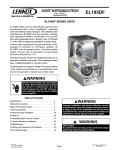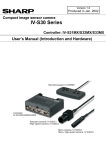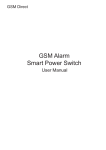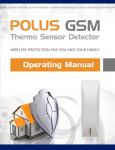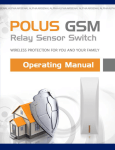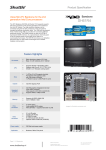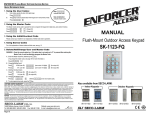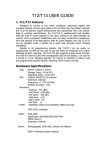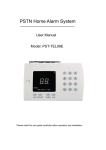Download Operation manual - Compound Security Systems
Transcript
1 POLUS GSM WIRELESS MAGNETIC SECURITY DOOR\WINDOW SENSOR OPERATING MANUAL CONTENTS 1 DESCRIPTION AND OPERATION 1.1 Function 1.2 Security Alarm Sensor Device Package Contents 1.3 Technical Specifications 1.4 Security Alarm Sensor Structural Design 1.5 Magnet Design 1.6 Keychain Magnet Design 1.7 Function and Operation of the Security Alarm Sensor 2 SET-UP PROCEDURE 2.1 Preparing and Operating the Alarm Device 2.2 Configuring the Alarm Device 2.3 Accessing the Programming mode 2.4 Setting-up for the First Time Use 2.5 Verifying set-up 2.6 Changing & Adjusting the Parameters 2.7 Security Alarm Sensor Device Installation 3 TROUBLESHOOTING 4 CONTACT INFORMATION 2 1 DESCRIPTION AND OPERATION 1.1 Function The POLUS GSM Security Alarm Sensor Device is designed and made to detect the unauthorized opening of doors, windows and hatches, etc., and when triggered, to transmit an SMS alert notification and/or place a call to the owner’s telephone. The alarm device supports the following operational modes: - Programming; - Disarmed; - “ArmDelay”; - Armed “On Guard”; - Active “AutoArm” Delay; - Alarm; - Standby “NotDelay”; POLUS GSM Security Alarm Sensor Device FEATURES: - Installs at any location with mobile GSM reception; - Arms via a key chain magnet and/ or an optional external button/ switch (optional external button/ switch not included in the package); - Disarms via a mobile telephone during Active “AutoArm” Delay, Alarm or Standby “NotDelay” modes; - Automatically re-arms to “On Guard” mode after a triggered “Alarm”; - Settings programmable via mobile telephone, online and thru utilizing “Configurator Express GSM” Android & iOS apps; - Expandable to link up with external magnetic security sensors or with any device that triggers an alarm signal via the opening of contacts; - Operates on a single 3 volt CR123 lithium battery for up to 12 months; - Built in power saving economy mode option available by disabling SMS armed/ disarmed notifications; - Automatically detects remaining balance inquiry telephone number; - The device is designed to operate indoors and guard around the clock 24/7 in stable non-extreme conditions. 1.2 Package Contents Include (In accordance with chart 1) Chart 1- Contents POLUS GSM Magnetic Security Alarm Sensor Device Magnet Lithium CR123A 3V battery Keychain magnet User's manual 1 (one) 1 1 1 1 3 (one) (one) (one) (one) 1.3 Technical Specifications (In accordance with chart 2) Chart 2- Primary Technical Specifications DESCRIPTION VALUE Gap (between the Security Alarm Sensor & more (than) 8mm Magnet) at which an Active “Notdelay” or an “Alarm” signal is generated Distance at which a “Normal” signal is restored less (than) 6mm Operating distance between keychain Magnet and 10mm Alarm Sensor Device, not to exceed GSM Module Operating Standards GSM-800/900/1800/1900 Quantity of telephones to be notified (6) six Time lapse for notification 20-40 seconds Battery type 1 x CR123A 3v Uninterrupted operating life span using one up to 12 months battery at a temperature of +25C Temperature operating range from -10 to +50 C Enclosure durability level IP40 Relative operating humidity @ +35c without 93% condensation, not to exceed Alarm Sensor Device size & dimensions do not 109x32x27.5 mm exceed Magnet size & dimensions, do not exceed 56.5x18x15.7 mm Alarm Sensor Device (w/ battery)/ Magnet weight 60 g/ 10 g do not exceed *(Footnote) - the Security Alarm Sensor will operate below -25c, but battery operating life span and quantity of SMS's sent will be reduced. 1.4 Security Alarm Sensor Design The Alarm Sensor device unit consists of a cover body with a light diode indicator and a base (diagrams 1 & 2). Inside the cover body, mounted on the base is the controller circuit board, to which the GSM module is attached (diagram 3). The circuit board and cover body attach to the base unit using clips. The cover body and base unit are made of ABS plastic. 4 Light diode indicator Cover body Guide mark Diagram 1: Security Alarm Sensor device design; General view. Diagram 2: Security Alarm Sensor device design; Top & bottom view. The controller circuit board (refer to diagram 3) contains magnetic sensors (the primary sensor- detection sensor DD1 & the arming sensor DD2), battery holder GB1, audio indicator BQ1, two color light diode indicator VD1 and a terminal block X2 in order to connect an external arming switch or additional optional external wired sensors. 5 The two color light diode indicates the state of the Security Alarm Sensor device in accordance with chart 3. The GSM module circuit board contains a SIM cardholder (XS3) and a “GSM” light diode to indicate network signal strength. X2 DD1 IN XS3 GB1 VD1 GSM BQ1 module GSM DD2 Diagram 3: Exposed view of the controller circuit board and GSM module The Security Alarm Sensor device is shipped with an installed battery insulated from the contacts by a protective plastic insert (refer to diagram 7). 1.5 Magnet Design The Security Alarm Sensor device includes a magnet (diag.4). The magnet unit consists of the base and cover body. A permanent magnet is installed in the cover body and is firmly snapped on to the base. The cover body and base unit are made of ABS plastic. Cover body Guide mark Base Mounting holes Diagram 4: Exposed View of the Magnet Unit 6 The Security Alarm Sensor device installs with 2 screws using the mounting holes found on the base or by using double-sided scotch tape (refer to diagrams 2, 4 & item 2.7). 1.6 Keychain Magnet Design The keychain magnet is a permanent 18x10x1.5 mm. constant magnet; dimensions: Diagram 4a: Exposed view of the Keychain Magnet 1.7 Functional and operational basis of the Security Alarm Sensor 1.7.1 Functional concept of the Security Alarm Sensor Device In “On Guard” mode, when the door opens (triggered violation), the magnet ceases to effect the magnetic detection sensor (or the external wired relay sensor), the Security Alarm Sensor Device generates “Active Delay” & “Alarm” signals which in turn execute notification. 1.7.2 Primary functions of the Security Alarm Sensor The Security Alarm Sensor performs the following functions: - detects unauthorized penetration (breach) of the protected door(s); - transmits an alarm SMS and/ or a call to the telephone numbers registered on the Security Alarm Sensor SIM card; - transmits an armed/ disarmed SMS to the primary notification number (optional); - automatically resets to “On Guard” mode (an SMS re: auto reset is not sent); - automatically requests remaining Security Alarm Sensor SIM card balance and transmits an SMS to the primary notification telephone number; - automatically detects remaining balance inquiry telephone number. 1.7.3 Primary functions of the Keychain Magnet The Keychain Magnet performs the following functions: - arms the Security Alarm Sensor; - cancels arming the Security Alarm Sensor during “active ArmDelay” mode (from 15 to 250 seconds depending on selected setting; refer to Chart 4, cell# 19); - verification of the Security Alarm Sensor operating mode: Armed “On Guard” mode or “Disarmed” mode. 7 1.7.4 Operating modes of the Security Alarm Sensor Upon activating power (by either removing the protective plastic insert from in between the battery and contacts or by inserting a battery), the Security Alarm Sensor enters “programming mode”; one (1) minute after set-up programming concludes, the Security Alarm Sensor enters “Disarmed” mode. Upon arming (using the Keychain Magnet or an optional external button/ switch), the Security Alarm Sensor enters “Arming” mode for a span of 15 to 250 seconds (“ArmDelay”, Chart 4, Cell# 19). If necessary, during the delay span, “Arming” can be aborted by using the Keychain Magnet or an optional external wired button/ switch. After the delay countdown span concludes, the Security Alarm Sensor will exit “ArmDelay” mode and enter Armed “On Guard” mode. In order to verify Armed “On Guard” mode, while in “On Guard” mode, pass the Keychain magnet in close proximity to the Security Alarm Sensor location or press the optional external wired button/ switch (if installed) and the Security Sensor Alarm will flash briefly and emit a beep (refer to Chart 3). In Armed “On Guard” mode, when a violation is detected (e.g. the opening of a door, etc.), the Security Sensor Alarm will enter “NotDelay” mode for a span of 0–250 seconds (Notification Delay, Chart 4, Cell# 20). In the event of an authorized opening, during the “NotDelay” countdown time span, the Security Sensor Alarm can be “Disarmed” by calling from one of the six-notification telephone numbers previously programmed into the Security Sensor Alarm SIM card; the Security Sensor Alarm will then enter “Disarmed” mode. In the event of an unauthorized opening (violation), after the “Active “AutoArm” Delay” time span has expired, the Security Sensor Alarm will enter “Alarm” mode and will proceed to send notifications via SMS and/ or calls. After the initial standby “AutoArm” of 0 – 250 seconds expires (Chart 4, Cell# 17), the Security Sensor Alarm will exit “Alarm” mode and will enter Standby “NotDelay” mode. While in this mode and with no additional violations (e.g. the door closed), the Security Sensor Alarm will enter Armed “On Guard” mode. While in “Alarm” and Standby “NotDelay” modes, it is possible to disarm the Security Sensor Alarm by a call from a mobile telephone. After being called, the Security Sensor Alarm will enter “DisArmed” mode. 1.7.5 Security Alarm Sensor Indicators The Security Alarm Sensor has built-in light and sound indicators. In addition, the GSM light diode indicates GSM signal strength. Indicator descriptions can be found in Chart 3. 8 Chart 3- Security Alarm Sensor Indicators Event/ Mode Light Indicator Sound Indicator Power On GSM Network Search GSM Network Activation (At Start-up) Programming Mode Security Alarm Sensor Incoming Call or SMS Disarmed Mode ArmDelay Mode Glows Red Glows Red - Flashes Red/Green 3 Beeps GSM Light diode Indicator Glows Red 3 Sec. Flashes for 20-40 Sec. Once every 4 sec. Glows Green - Audio Beep - - - - 1 Beep per sec. during Delay Span - Glows Green Short Audio Chirp - Glows Red - - Flashes Green - - Flashes Red Audio Beeps 3 per sec. - - Armed “On Guard” Mode Operating Mode Verification Using Keychain Magnet (Button/Switch) In Armed “On Guard” Mode “Attention” Error Mode During GSM Network Search AutoArm Delay Mode “Alarm” Mode Standby “NotDelay” Mode - - - 1.7.6 Notifications The Security Alarm Sensor transmits an armed/ disarmed (Diag. 5a & 5b) status SMS notification to the number 1, primary, telephone registered to receive notifications (“1SMS”, see: Chart 4) and “Alarm” notifications to the numbers registered at “1SMS”…”6SMS” (Diag.5b). The number registered at “1SMS” will also receive SMS notifications containing selected settings (Item 2.4, diag. 8) and Test/status SMS notifications showing remaining SIM card balance. 9 Test/status SMS notifications are sent depending on selected interval (Chart 4, Cell# 14). The interval time reference point starts with the receipt of the settings notification. When an “Alarm” is triggered, the Security Alarm Sensor will transmit an SMS notification, place a call to the first registered (primary) number and will then place calls to the remaining numbers together with transmitting SMS notifications. The Security Alarm Sensor will cease calling one number and will continue to call the next number under the following circumstances: - When the subscriber does not pick-up within 30 seconds. - When the subscribers line is busy. - When the subscriber is not connected to a network. Calling out will cease after one of the subscriber numbers picks up and disconnects; then the Security Alarm Sensor will transmit “Alarm” (Diag. 5c) notifications to the numbers located at “2SMS”…”6SMS”. Armed SNN% Diag. 5a SMS “Armed” Disarmed by a call from +1ХХХХХХХХХХ SNN% Diag. 5b SMS “Disarmed by a call from…” Alarm SNN% Diag. 5c SMS “Alarm” S- indicates network signal level; NN- indicates network signal level as a percentage (e.g. S50%, S75%, etc.) The value indicating network signal level (SNN%) is included in all SMS notifications, except for notifications containing remaining SIM card balance. 1.7.7 Arming and Disarming Protecting the premises by arming the Security Alarm Sensor is accomplished with the assistance of a keychain magnet (or with an optional external button/ switch). Disarming is accomplished by placing a call from any one of the mobile telephones registered to the Security Alarm Sensor SIM card. 10 In order to “Arm” the unit, briefly (1-2 sec.) bring the keychain magnet up to where the Security Alarm Sensor magnet is located (see: Diag. 9 & 3) or briefly (1-2 sec.) press the optional external button/ switch (if installed). For the duration of 30 seconds (default ArmDelay setting), the Security Alarm Sensor will emit audio chirps. During this duration of time, it is necessary to close the door. At the conclusion of the time delay, the Security Alarm Sensor will enter “Armed” mode. During the span of the time delay, arming can be cancelled with the assistance of the keychain magnet (briefly bring the keychain magnet up to where the Security Alarm Sensor magnet is located or simply press the optional external button/ switch. In order to “Disarm” the unit, place a call from any one of the mobile telephones registered to the Security Alarm Sensor SIM card. Attention: Disarming is only possible in Active “AutoArm” Delay, Alarm & Standby “NotDelay” modes, i.e. in the absence of a triggered “Alarm”, in order to “Disarm” the unit, it is necessary to open the door. In the event that the “ArmDisarm” cell (see: Chart 4, cell# 16) on the Security Alarm Sensor SIM card contains and indicates “1”, the primary notification number will be sent an SMS containing the text “Armed” or “Disarmed by a call from…” (see: Diag. 6a, 6b). If, while in Armed “On Guard” mode, a violation is detected and the “Notification Delay” time span expires (default setting of 40 seconds, see: Chart 4, cell# 20), the Security Alarm Sensor will transmit “Alarm” SMS messages (see: diag. 8) and/ or will execute calls to the registered telephone numbers, depending on the notification parameter selected (see: Chart 4, cell# 18). In case the “Notification Delay” time span is set to between 0-20 seconds, the Security Alarm Sensor will without any additional delay proceed to execute notifications because the “Notification Delay” time span includes the time required for the GSM module to power up and for the SIM card sign-on to the network. The required time for GSM module power-up and SIM card network sign-on is 10-30 seconds. After the Security Alarm Sensor concludes transmitting Alarm notifications, it stands by to receive incoming calls from numbers “1SMS”…”6SMS” in order to Disarm. Upon receiving an incoming call, the Security Alarm Sensor will reset the call, transmit an SMS to the primary number containing “Disarmed by a call from +1xxxxxxxxxx” (when value “1” is indicated in the “ArmDisarm” cell location) and will then enter “Disarmed” mode. In the event there is no incoming call received within 60 seconds after the notification delay cycle concludes (default setting, see: Chart 4, cell#17) and there is no further violation (door closed),the Security Alarm Sensor will enter Armed “On Guard” mode. 11 1.7.8 Operating the Security Alarm Sensor using External Alarm Sensors If necessary, external magnetic alarm sensors (further referred to as “external sensors”) (one or more) or any other device that generates an “Alarm” signal via the opening of contacts, can be connected to the Security Alarm Sensor. When operating the Security Alarm Sensor unit with external sensors, in Settings (Chart 4) cell# 37, it is necessary to select value “1” or “2”. When operating the Security Alarm Sensor unit with external sensors, arming is limited to using the keychain remote (arming via an external button/ switch is not available). 1.7.8.1 If value “2” is indicated in cell# 37, an Alarm signal will be generated when any of the sensors; either an external sensor or the Security Alarm Sensor is triggered. Link-up diagram: see diag. 6a 1.7.8.2 POLUS GSM Detection sensor switch IN magnet Diag. 6a Sensor switch Sensor switch Sensor switch magnet magnet magnet Link-up diagram for External Sensors/Switches. Value “2” @ cell#37 1.7.8.3 Indicating value “1” @ cell# 37 allows for two link-up operating options: Option 1- The Security Alarm Sensor is installed without a magnet, i.e. it does not operate as a magnetic detection sensor; see diag. 6b. The Alarm signal is generated only when any one of the external sensors are triggered. POLUS GSM Detection sensor switch Diag. 6b IN Sensor switch Sensor switch Sensor switch magnet magnet magnet Link-up diagram for External Sensors/Switches. Value “1” @ cell#37 Option 2- The Security Alarm Sensor is installed with magnet, i.e. it operates as a magnetic detection sensor. The Alarm signal is generated only when two of the sensors are triggered; an external sensor with a mandatory Security Alarm Detection Sensor. 12 Installation option: E.g., both the Security Alarm Sensor and external sensor are installed on the same door. The door becomes ajar, no “Alarm” is generated (only one sensor triggered). When the door opens completely an “Alarm” is generated when both sensors are triggered. Link-up diagram: see diag. 6c. POLUS GSM Detection sensor switch IN magnet Sensor switch magnet Diag. 6c 2 SET-UP PROCEDURE 2.1 Preparation of the Alarm Device for Operation After opening the package, visually inspect the Security Alarm Sensor Device for any physical defects and make sure all parts are included. Check and make sure there is a sufficient SIM card balance. 2.2 Configuring the Alarm Device At initial power-up, the Security Alarm Sensor records on to the SIM card the following parameters and values in accordance with Chart 4. Chart 4- Security Alarm Sensor Settings Cell# Position 1 Cell label Default Value Description Available Values 1sms 000 2 3 4 5 6 7 2sms 3sms 4sms 5sms 6sms BALANS 000 000 000 000 000 0 1st telephone number (primary) for notification Telephone numbers for notification Enter number in the following format +1********** e.g.:+17180000000 Enter number in the following format +1********** e.g.:+17180000000 Remaining balance Inquiry USSD Auto detection of remaining balance tel. number; Manual entry of tel.# e.g.: *100# 13 14 TEST 7 Frequency for test/ status SMS notifications 16 ArmDisarm 1 17 AutoArm 60 18 AlarmNot 1 Send SMS when armed/ disarmed mode activated Reset time pause interval after a triggered Alarm. After sending Alarm notifications, the Alarm Sensor pauses for up to 250 seconds, checks for the presence or absence of additional violations and if absent will Arm; A notification that the Alarm Sensor has rearmed is not sent. Alarm notificatio n Option/Type during Alarm mode. 14 Sets frequency for test/ status SMS notifications. Interval sets up to 250 days. E.g.: 1- Notification once a day 7- Notification once a week 0- Notification not sent. 0- Do not send 1- Send Interval parameter must be between 0250 seconds. e.g.:60 - 60 sec. after Alarm notifications complete and no additional violations occur, the Alarm Sensor will enter Armed “On Guard” mode. 0 - Only SMS to 1sms...6sms 1 - Call + SMS (SMS sent to 1sms, then calls placed to all tel. numbers, followed by SMS transmittal to all remaining tel. numbers @ 2sms... 6sms. 3 - Only calls placed to 1sms...6sms 19 ArmDelay 30 Arming delay in Parameter in Seconds. seconds between 0250 sec. 20 NotDelay 40 Notification Parameter should delay, be between 0-250 after triggered sec. alarm, in order to allow disarming in seconds. 25 TriggerAlarm 0 Turns Alarm 0- on Sensor sound 1- Off off/on during triggered alarm. 34* POLUS 0 Template name 0 w/settings. 35 mnum 000 For operation SIM Tel. #Alarm w/Polus GSM Sensor Security Panel application. 36 Lang 0 Notification 0-Ru Language 1-En 37 EXTIN 0 Link-up 0- No; Ready to external Link-up external sensors Arming Button/ Switch only1 or 2Yes; Link-up diagram see:1.7.8 *- Operating service parameters& values; settings created in template during Polus GSM Security Alarm Sensor set-up. 2.3 Accessing the Programming Mode In order to access “Programming” mode, consecutively execute the following actions. 1. Install the SIM card as shown in diag. 7. Caution! Prior to installing or removing the SIM card, it is necessary to deactivate the Alarm Sensor electrical supply! (i.e. install the protective plastic insert or remove the battery). 15 Remove X2 the protective plastic insert DD1 IN XS3 VD1 Battery Power Source SIM Card GSM Installation SIM Card DD2 Protective plastic insert Diag. 7 SIM card installation; protective plastic insert removal 2. Remove the Protective Plastic Insert from in between the contacts and the battery (see diag. 7) or install a battery using correct polarity (if it had been previously un-installed). 3. The Security Alarm Sensor light diode indicator will glow red. The “GSM” light diode will glow for 3 seconds and will begin flash quickly. 4. Wait for the SIM card to register on to the network. At the conclusion of registration, 3 beeps will be heard and the “GSM” light diode will flash (1) once every (4) four seconds. The Security Alarm Sensor light diode indicator will glow green. This indicates that the Security Alarm Sensor has entered the “Programming” mode. During the entire duration of the “Programming” mode, the light diode indicator will glow green. In the event the “GSM” light diode continues to flash quickly, (the SIM is not registering on the network) might be due the SIM card being incorrectly or not installed, blocked by a PIN code or the GSM network is inaccessible (take action in accordance with Chart 5). Upon entering the “Programming” mode, the Security Alarm Sensor sends an SMS notification with settings to the primary notification telephone number (if the primary number was previously recorded in the SIM card memory). For the span of (1) one minute, the Security Alarm Sensor remains in “Programming” mode and stands by for an incoming call and/ or SMS containing any changes to the settings. In the absence of an incoming call/ SMS, the Security Alarm Sensor at the expiration of (1) one minute enters “Disarmed” mode. In the event of an incoming call/ SMS occurring and being accepted, the Security Alarm Sensor at the expiration of (1) one minute, will enter “Disarmed” mode and will transmit an SMS notification reflecting the changed settings to the primary telephone number. 16 2.4 Setting-up for the First Time After powering-up the Security Alarm Sensor, a template with cells containing default values will be created on the SIM card phone book (in accordance with Chart 4). At a later time, you are able to edit these parameters and values. It is necessary to record notification telephone numbers to the SIM card. Perform the followings steps consecutively. 1. Access “Programming” mode in the device (see item 2.3). 2. Begin by calling the Security Alarm Sensor SIM card telephone number from the telephone number that will be used as the primary notification number. After receiving and recording the number, the Security Alarm Sensor will disconnect the call and emit (1) one audible confirmation beep. This number will be recorded in cell# 1 “1SMS” (see Chart 4) and as the designated primary number, will be sent an SMS notification from the Security Alarm Sensor indicating “Setting Reset, Number Added+1xxxxxxxxxx”. 3. Proceed to record any additional notification telephone numbers by calling from them and after each additional number is recorded, an SMS notification is sent to the primary telephone number containing “Number Added+1zzzzzzzzzz”, “Number Added+1zzzzzzzzzz” etc. 4. One (1) minute after the last call is received, the Security Alarm Sensor will transmit an SMS containing the settings to the primary telephone and will then enter “Disarmed” mode. If you were unable to record all the necessary additional notification telephone numbers, either put in the Protective Plastic Insert between the battery and contacts or remove the battery, wait (2) two minutes and repeat the procedure from the beginning- see item 2.6. 1) Primary notification number Received from +1YYYYYYYYYY 14) Frequency of 1)+1XXXXXXXXXX,7)*100#, test/status Notifications 14)1,16)1,17)60,18)1,19)30, 16) Send SMS Arm/Disarm 20)40,25)0,36)1,37)0,SNN% 17) Alarm Reset Time Pause 20) Notification Delay 25) Alarm Sensor Alarm Sound On/Off Signal Strength Diag.8- Sample SMS with Settings 17 Security Alarm Sensor number 7) Balance Inquiry 18) Alarm notification option 19) Arming Delay 36) Notification language 37) Connect External Sensors 2.5 Verifying Set-up 1. Bring the Keychain magnet up to the Security Alarm Sensor to be armed (see diag. 3 & 9). For (30) thirty seconds the Security Alarm Sensor will emit audible chirps. Within this time span, it is necessary to locate the Magnet in proximity to the Security Alarm Sensor as shown in the installation description (see diag. 9). 2. Wait to receive an SMS notification containing the text “Armed” (default setting; possible to turn off). 3. Wait for 2-3 minutes, then move the Magnet away from the Security Alarm Sensor for a distance greater than 8mm (see Chart 2), the light diode indicator will glow red (while registering on the GSM network, then blink green as it enters Active “AutoArm” Delay mode. 4. After (40) forty seconds (default setting), the light diode indicator will blink red, showing that the Security Alarm Sensor has entered the “Alarm” mode. 5. Wait to receive an SMS notification containing the text “Alarm” and a telephone call from the Security Alarm Sensor. 6. Place a call to the Security Alarm Sensor telephone number. 7. Wait for an SMS notification containing the text “Disarmed by a call from +1xxxxxxxxxx”; the Security Alarm Sensor has now entered “Disarmed” mode and light/audio indicators are turned off. 2.6 Changing the Parameter Value Settings Value parameter settings are installed during the (1st) first power-up and later be changed. The parameter values can be changed using the following methods. Method-1 The Security Alarm Sensor settings can be configured by using the “Online Service” located at service.alpha-safe.com, by utilizing the “Express GSM Configurator” for Android or iOS or by using the application for central monitoring “GSM Panel” available for download from play.google.com (search: “Express GSM” or “GSM Panel”). The created configuration will be sent to the Security Alarm Sensor SIM card. Method-2 1. Using the primary notification telephone, create an SMS message using values in accordance with Chart 4. For example, in order to change the notification method, it is necessary to send an SMS message containing the following text: “18)0”; where 18) indicates the cell number and 0 indicates the selected parameter value. Note: Characters are entered without quote marks and spaces. 18 In order to change several parameters, it is necessary to list the parameters separating them with a comma. For example: «2)+1xxxxxxxxxx,16)0,18)0,19)60» etc. Note: Characters are entered without quote marks and spaces. 2. Access “Programming” mode in the Security Alarm Sensor (item 2.3). 3. Send a prepared SMS message to the Security Alarm Sensor telephone (SIM card) number. 4. Wait to receive an SMS notification confirming selected parameter values. Method-3 It is possible to change and configure the parameter values directly with the aid of a GSM mobile telephone. In order to accomplish this, install the Security Alarm Sensor SIM card into a GSM mobile telephone. To access the necessary parameter, open the telephone book, select the cell to be altered and make the necessary changes in accordance with Chart 4. For example, in order to change the primary notification telephone number, in the telephone book select “1SMS”, then select “change”, erase the old number and record the new primary notification telephone number, etc. Note: Some mobile telephones do not support this function. In addition to the change parameter methods listed above, adding/ deleting notification telephone numbers can also be accomplished via a telephone call from the primary notification telephone number to the Security Alarm Sensor while in “Programming” mode (see item 2.4). After calling from the primary notification telephone number, all telephone numbers contained in the SIM card memory are erased and it will be necessary to add all required telephone numbers all over again. 2.7 2.7.1 Security Alarm Sensor Installation The Security Alarm Sensor should be installed at a location that will be shielded from atmospheric elements, physical damage and access by unauthorized strangers and at the same time, have access to a reliable GSM signal. The Security Alarm Sensor should be located away from high power cables. Installing the Security Alarm Sensor without External Sensors The body of the Security Alarm Sensor and Magnet must be installed parallel to each other, with each of the guide marks facing each other 19 and maintaining proper clearance between them (see: diag. 9 & Chart 2). The Security Alarm Sensor should be mounted on a non-movable surface (for example, on a door jamb) and the Magnet on a movable surface (for example, directly on a door). Diag. 9- Installation Diagram with Connection Specifications In order to install the Security Alarm Sensor execute the following steps consecutively: 1. Mark-out and measure the selected location for installation, taking into account and allowing for openings on the body of the Security Alarm Sensor and Magnet. 2. Install the Security Alarm Sensor by removing the cover and the circuit board from the base. Attach the base using two screws, then snap-in the circuit board followed by the cover. If required, hook-up an external switch/ button- see: diag.10 external switch/button POLUS GSM IN Diag. 10- Diagram for Hooking-Up an Optional External Switch/ Button 3. Install the Magnet by removing the cover and fastening the base down by using two screws, then re-attach the cover to the base. Double sided tape can be used for attaching to a prepared surface. 20 Inspect that the installation was correctly performed and verify operational integrity as described in item 2.5 (by arming the device and opening the door). If an external switch/ button was installed, test arming (and disarming) the Security Alarm Sensor by briefly activating the optional external switch/ button. 2.7.2 Installing the Security Alarm Sensor with External Sensors Install the Security Alarm Sensor and External Sensor at the intended locations. Attention! In the Security Alarm Sensor settings, @ cell#37, value “1” or “2” must be selected. Verify the correct installation of the external sensor (as described in item 2.5) and check the proper operation of each installed Alarm Sensor. 3- TROUBLESHOOTING Chart 5- Troubleshooting Guide Description of Symptom No Audio beeps or “GSM” light diode flashes in the Alarm Sensor after the Battery is installed. Possible Cause Solution 1. Battery improperly installed; 2. Battery is discharged When arming using the Keychain magnet, there Is no response from the Alarm Sensor ( No audio Beeps during the arming Delay span; see chart 3) After powering up the Alarm Sensor (installing The battery) the “GSM” Light diode flashes rapidly & does not flash once (1) Every (4) four seconds as Required (SIM card is not Logging on to the network) The keychain magnet is more than 10mm away from the Alarm Sensor 1.Remove the battery & re-install properly using proper polarity; 2.Install a new fresh Battery: CR123A 3v Reduce the distance between the keychain magnet and Alarm Sensor 1.SIM card is not installed; 2.SIM card is incorrectly installed; 3.SIM card is locked with a PIN code; 4.”GSM” network is inaccessible. 21 1.Verify the presence of a SIM card; 2.Remove SIM card & reinstall as shown in diag.7; 3.Disable the SIM card PIN code feature by using a GSM Telephone (see telephone operating manual). 4.(a) Re-locate the Security Alarm Sensor to a spot with good access to a GSM Network signal. (b)Change the mobile network provider. 4- CONTACT INFORMATION ALPHA ARSENAL, LLC 104-20 Queens Blvd., Ste 1B Forest Hills, NY 11375, US T/F: +1.718.440.3281 +1.718.355.9281 Skype: alpha.arsenal E-mail: [email protected] [email protected] Website: www.alpha-safe.com 22 23
























